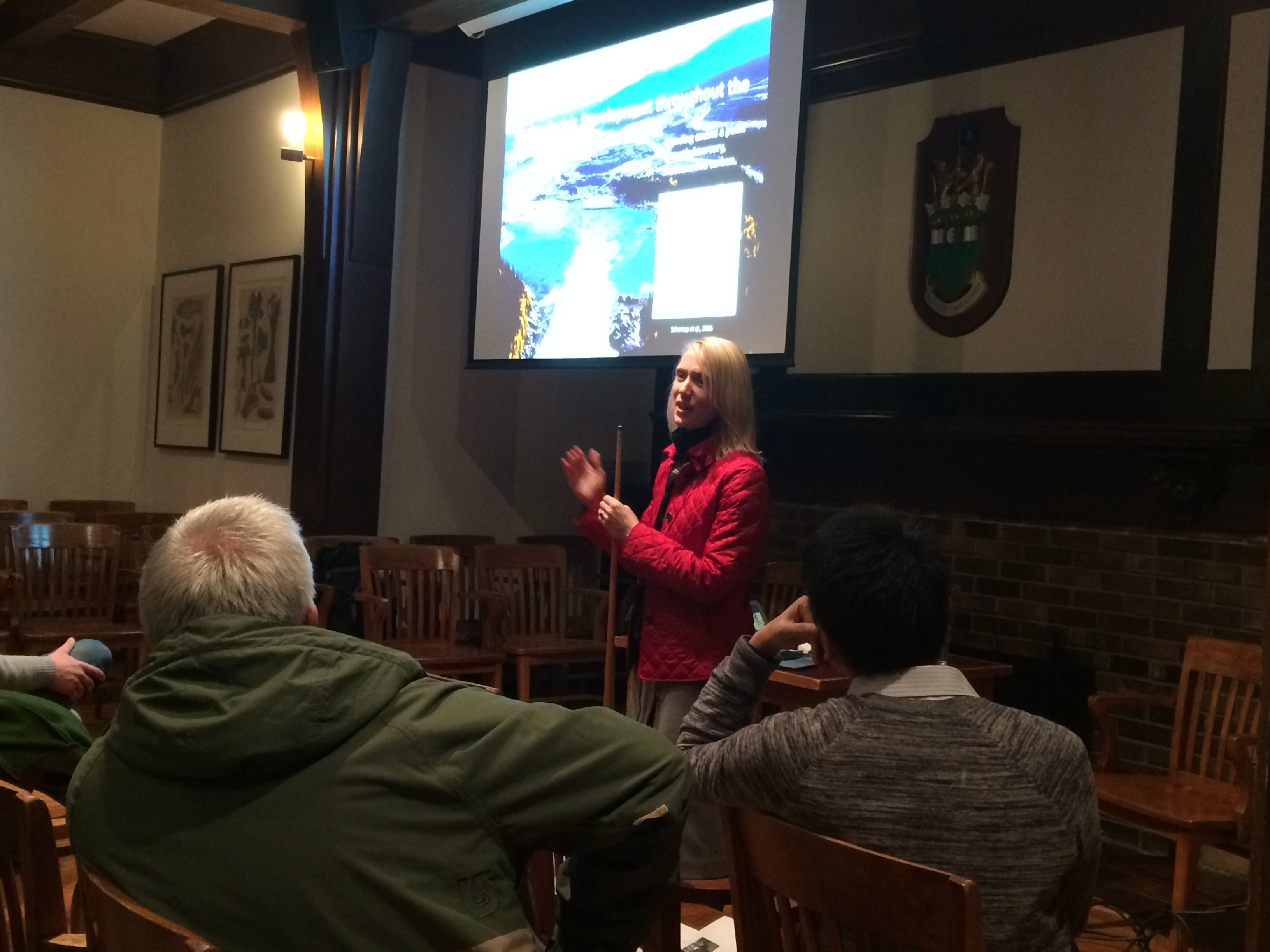By: Valentina Ruiz Leotaud.
On November 17th, the Nereus Program hosted a talk with a VIP guest speaker: Dr. Elsie Sunderland, the Thomas D. Cabot Associate Professor of Environmental Science and Engineering at the John A. Paulson School of Engineering and Applied Science at Harvard University.
In an hour-long presentation, which took place at UBC’s Green College, Dr. Sunderland summarized part of the work that her research group is undertaking on the biogeochemistry of global contaminants.
Many environmental contaminants biomagnify in marine food webs, reaching high concentrations in top predators, which means that they are posing health risks to humans and wildlife.
Sunderland started by saying that focusing just on carbon pollutants provides a very narrow view that ignores the vast array of substances affecting the environment. Even when policymakers think they are choosing the greenest options when it comes to energy generation, they might be doing quite the opposite.
“Our energy choices have ramifications for many other types of pollutants,” she said. “Hydroelectric: when we flood our reservoirs we actually cause a dramatic pulse in methylmercury production, which is neurotoxic, and we also cause a pulse in CO2 and methane,” she explained.
Since most renewable energy plans in North America involve some sort of hydroelectric development, Sunderland believes that it is necessary to talk about the “side effects” of this type of energy generation. She highlighted the fact that many Indigenous communities living around these facilities will be affected by the increased concentrations of pollutants in their water sources.
Her research on the Muskrat Falls hydroelectric dam forecasts that methylmercury levels will double in people living downstream from the falls.
In other words, the fact that decisions around clean energy are taken almost blindly is making us conduct a global chemical experiment not only with our planet but also with our health, she said.
The worst part? Once neurotoxins penetrate the human body -epidemiological studies have shown- the effects on people’s lives are permanent. She calls this phenomenon a “silent pandemic.”
Methylmercury is the only form of mercury that biomagnifies in food webs, Sunderland explained. That means that even though it might exist in low concentrations in the soil or water, once it moves up the trophic levels (from plankton to small fish to big fish to humans) concentrations reach higher values.
“It reaches very high concentrations in top predators (106 or a 107), it has a very high absorption efficiency and it stays in your body for a relatively long time.”
The expert said that once methylmercury has entered the organism, there’s not much a person can do about it. “The only thing you can do is stop consuming methylmercury, which comes predominantly from fish.” The substance is associated with impaired cardiovascular health, endocrine disruptions, and immunotoxicity.
“So we need to ask where do the fish that we eat come from?” Sunderland said. She continued explaining that the standard individual in North America gets fish from the commercial seafood market which, in turn, “comes from everywhere.”
Showing the “usual suspects,” tuna and swordfish, she said that as top predators they tend to be high in methylmercury. Thus, most of the MeHg people are consuming comes from these sources.
Two different tuna species, in fact, accounted for almost 40% of the US methylmercury intake from the years 2000-2010. “What we actually see -and this is fascinating- in the shift in the type of tuna that people are eating is that there has been, in this past decade, an explosion of fresh sushi meals and fresh sushi, especially the tuna, has much higher mercury concentrations than the category of consumption that has declined, which is light canned tuna,” she mentioned.
But, besides the aforementioned hydroelectric processes, how does methylmercury get into fish?
On this video, Dr. Elsie Sunderland reveals what anthropogenic activities release mercury into the environment.
Dr. Sunderland’s research group is also studying future scenarios for different species, for example, North Pacific tunas, considering whether anthropogenic mercury emissions remain the same or are controlled globally.
But not everything is clear-cut. Such scenarios have to take into account what happens, for example, if emissions are reduced but water temperatures keep rising due to climate change. For some species, even if methylmercury concentrations in their diet declines, rising water temperatures cause an increase in MeHg in their bodies.
The main objective of Dr. Sunderland’s study is, thus, to determine the cumulative effects of contaminant exposure to marine fisheries and to human health, in order to move people, and particularly policy makers, to think about mitigating measures that reduce both carbon and mercury emissions.
Watch her full presentation on this video.
https://www.facebook.com/NereusProgram/videos/1374659939225320/




